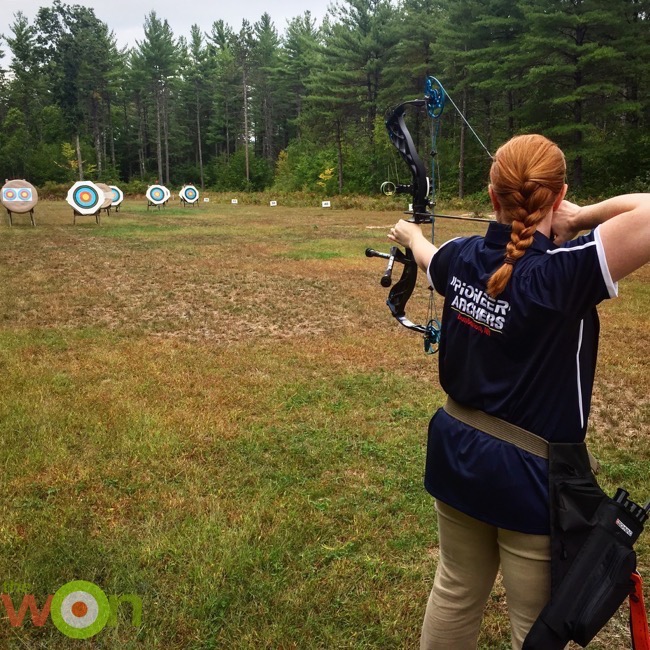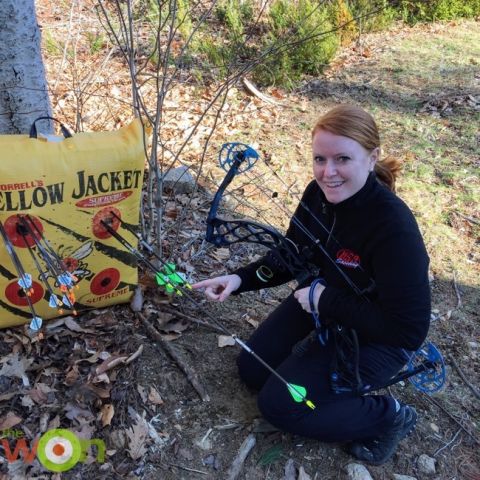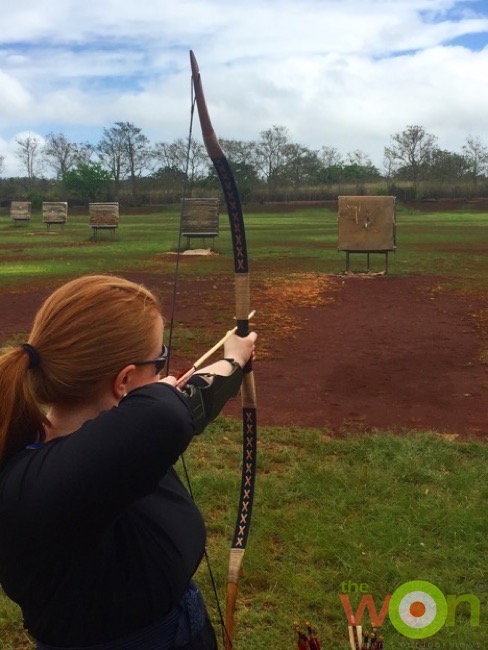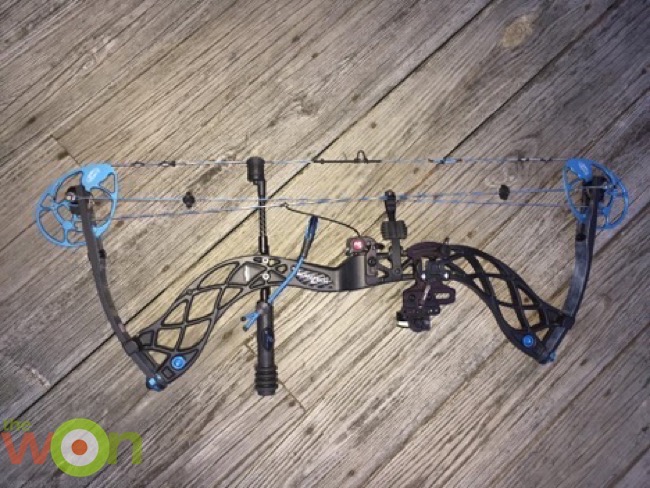Do you appreciate the beauty of the great outdoors? Are you drawn to the idea of eating organic, free-range, locally sourced food? Do you like to see the results of your hard work? Do you think I’m a crazy person for asking seemingly unrelated questions under the headline of an article about archery? If you answered yes to any of the previous questions, you should strongly consider learning to shoot a bow. And since it is February—the month of Cupid—let’s talk archery!

The author shooting her bow in preparation for an outdoor archery match. (Joshua Monroe photo)
With a bow, some arrows and proper technique, you’ll be able to experience the beauty of the outdoors, the thrill of an ethical harvest, and the excitement that comes with seeing your hard work pay off in the form of well-placed shots on target. Plus, the discipline of a shooting sport trains your brain in ways that benefit you at work and school. Of all the activities that get you outside and shooting things, how is archery the perfect sport for the outdoorsy, healthy-lifestyle-living, hard-working person to seek out? Let me count the ways…
Archery is relatively affordable. Once you get a bow and some field-tipped arrows, you can keep shooting until you wear out your equipment. Fair warning—if you work hard and get good, you might end up shooting into the back of previously shot arrows, in a “feels so good and yet so sad” Robin Hood-ed arrow.

A Robin Hood is fun: It means you are consistent. But too many of these can get expensive, since it destroys at least one of the arrows. (Joshua Monroe photo)
Archery is versatile and can be done just about anywhere. You can practice from 10 yards out to 100 yards with a bow and arrow, and you’ll be honing your skills and form at any distance. Since a bow isn’t a firearm, in most states you can safely loose arrows on your property without fear of noise complaints from neighbors (make sure you have a safe backstop, though!). Many recreation centers and firearms ranges have archery ranges set up as well.
Archery hunting is a timeless activity. Humans have taken bows with them on the stalk for prey for generations. If you choose to bowhunt, you’ll get the opportunity to shop Mother Nature’s grocery store for local, organic, free-range meat. This reconnection with our primal nature has advantages beyond the refrigerator. Bowhunting in most states means a longer hunting season, which in turn means more chances for a successful hunt than firearms-only hunting.
Ultimately, archery is fun. When you shoot a bow, you’ll feel like Katniss Everdeen from The Hunger Games and you’ll look like a goddess. If you work at it, you’ll probably shoot some center shots and experience the great feeling of doing something perfectly. (It’s awesome!) Plus, once you get started, you might be surprised at the number of people you meet who share a passion for archery and want to shoot with you.
So let’s assume Cupid’s arrow has struck, and your heart is set on archery. Where do you start? The first step to becoming an archer is to find a bow and learn to shoot it.

Archery is versatile and can be done almost anywhere, including at a public archery range at the Central Oahu Regional Park while on a Hawaiian vacation. (Joshua Monroe photo)
There are three main types of bows available to the modern archer. Long bows, modern recurve bows, and compound bows share the same basic physics, but with increasingly complex components. For the sake of brevity, I’m going to focus on compound bows from here on out since compounds are both popular and practical, and relatively easy to learn to shoot accurately.
How do you pick out a bow?
First, you don’t necessarily need to buy a bow to get started. Check out Archery360.com and local rec center listings to see if there are open archery courses where you could get a feel for different bows while getting some instruction. Sometimes archery pro shops will also offer courses, or a “try before you buy” option. The more data you gather, the better.
If you decide to purchase a compound bow, a few measurements will aid you in your search. Armed with your draw weight and draw length, you can shop either new or used bows and find something that fits you. An archery pro shop will be able to help you determine these measurements if you don’t feel comfortable doing it yourself.
There are a ton of archery brands out there who are making accurate, attractive compound bows. Hoyt, Mathews, Bowtech, PSE… you can’t go wrong with any one brand. As an engineer by trade, I cannot overemphasize the importance of gathering data before making a purchase. In addition to research of the brands and taking advantage of “try before you buy” offers, I recommend reading reviews from bow shops that operate online, like Lancaster Archery, Bass Pro, and Cabela’s. There are also specific gear review sites like Compound Bow Choice, The Best Compound Bows and Hunter’s Friend. Additionally, field trials like this one from Realtree are good to read, for the testers’ multiple viewpoints and varied experiences.
You’ve got options aplenty with style and budget. You can buy archery equipment either new or used. When my husband got started with archery, we opted to buy a used hunting bow from a coworker of mine who happened to be approximately the same size as my husband. This meant we got a bow with the right draw length and weight that was fully kitted out and ready to shoot for a good price. This is a viable option that will save some dough, if you’re willing to put the time into searching. I asked around at work and at my local gun club (which also has a big archery contingent), and searched online classifieds. When my better half decided he wanted to keep shooting archery and make the move into something with more accuracy, we again bought used to save money. He now shoots a Hoyt Pro-Comp Elite compound bow and loves it. If you do buy used, I highly recommend you take your new-to-you bow into an archery pro shop to check the strings and make any adjustments to get the bow to fit you properly.
I opted to buy a bare compound bow then accessorize for myself, rather than going with a package deal. Since I wanted to both target shoot and bowhunt, I chose my bow based on the fact that it was developed by a woman hunter for women hunters and archers: the Eva Shockey Signature Series bow by Bowtech. I appreciate the weight (with accessories, mine weighs 5.2 lbs), balance (it “feels” right in my hand) and aesthetics—it’s a good-looking bow! I’ve learned a bit more about what I like and don’t like in a bow since I made my purchase, and the next bow I buy will probably be more of a target bow, so that I can keep up with my husband. But for now, the Eva bow is perfect for me. I can take it to the range and perform well, and I can take it into the woods to hunt turkey and whitetail deer.

This bow is fully functional for target shooting or hunting. (Emily Monroe photo)
To get your bare compound bow ready to shoot, you’ll need the following:
Additional accessories that would be worth the investment once you are “sold” on archery include a solid case for your bow and a target to shoot while practicing at home. But these items, like many more that will enhance your archery experience, are icing on the cake. As you’re first getting started, give Cupid’s arrow time to take effect. Your love for archery is sure to grow if it is built on the firm foundation of a good bow and sound technique. Happy shooting, Katnisses everywhere!
This Retro WON first appeared February 14, 2017.
It started as sibling rivalry and grew into a lifelong passion. Target shooting is at the core of Emily Houston Monroe's past, present, and future. A decorated junior and collegiate rifle shooter, Emily now works as an engineer at a leading firearms manufacturer where she can bring her passion for firearms to a new level. In her blog The “How-To” Gun Girl, she will share her experience in various shooting sports. From targets to turkeys. From smallbore rifle up to .338 Lapua Magnum. From 10 meters to 1600 yards. If it is a shooting sport, the "How-To" Gun Girl will try it out and explain it all. View all posts by Emily Houston Monroe
Wonderful article. I am so interested in getting into bow hunting it’s almost painful… but I have NO idea where to start. Should I take classes? If so, how do I identify the best place to go? Once I’ve got the archery part down, how do I even find information on how to get into the hunting aspect of it? This information is so hard to find and it frustrates me like you wouldn’t believe :(. Do you have any of these answers??
Hi Emily! I started in archery by finding a local archery club (in my case, they met at my gun range) and contacting their generic “info” email address. I got in touch with a coach to make sure I got my bow set up to be able to bowhunt AND shoot in tournaments, and to make sure my technique was good from the start. To find a club or a coach, I would recommend the search functions on Archery 360 (https://www.archery360.com/where-to-shoot/) or USA Archery (http://www.teamusa.org/USA-Archery/Clubs/Find-a-Club). As far as finding info on bowhunting, I asked around with friends and family and found a surprising number of folks who bowhunt, and several of them were willing to walk me through hunter ed, getting a hunting license, and setting up my bow. One friend even walked around the property I had permission to hunt last fall to help me identify great spots. If your personal network is bereft of bowhunters, check out Bowhunting 360 for tips on equipment and where to hunt (http://www.archery360.com/category/bowhunting/). I also found a bunch of podcasts that were related to bowhunting that were helpful – just search “bowhunt” in your favorite podcast app.
Emily,
I enjoyed reading your article. My husband, Eric is a bow hunter and enjoys shooting deer and wild boar. This has helped me search for places to start practicing and learn more.
After your successful hunt, consider preparing your harvest with one of our wild game dinner kits. We will be in touch with WON.
Awesome, thanks for reading Leslie! Will you be joining Eric in the woods this year?
Not counting the low priced youth bows, a compound bow from the big box sporting goods store will run you $300 and up. That is more than I paid for my .308 Win deer rifle new, but less than my two AR15s.
Arrows aren’t cheap either, $5 each or more, but at least they are reusable.
Field points, 12 for $6
Broadheads. $10 each and up for hunting.
This could end up costing more than I care to spend after adding in the other accessories.
Considering my age and arm strength, I’ll stay with my rifles.
I did have a Bear WhiteTail Hunter in my younger days about 25 years ago.
Geoff, a good option to get started is to buy used like we did to get my husband into archery. We paid about $250 and got a bow that was about 7 years old, with 10 field tipped arrows, 3 broadheads, two wrist strap releases, an arrow rest, a 3-pin sight, and a field quiver. Because I was buying from a coworker I trusted, we got a great deal and it was basically ready-to-shoot after a check-up for string integrity at the local pro shop. For that price archery is hard to beat, even with the great ready-to-hunt packages many rifle manufacturers offer with gun, optic, and sling. Check out the classifieds (either online or at your local range) for some deals.
Excellent read and great information! I have yet to get through all the links. Thanks for the info I am just starting (as of last Fall) in archery and I was struck by Cupid’s arrow when I shot it the first time! I have the Mathews Avail, what a sweet bow it is!!